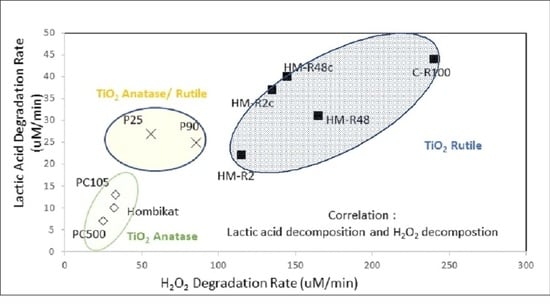Impact of H2O2 on the Lactic and Formic Acid Degradation in Presence of TiO2 Rutile and Anatase Phases under UV and Visible Light
Abstract
:1. Introduction
2. Results and Discussion
2.1. Comparison of the Impact of H2O2 on Formic and Lactic Acid Photocatalytic Degradation in Presence of P25, PC105 and C-R100
2.2. Impact of H2O2 on the Photocatalytic Degradation of Lactic in Presence of Different TiO2 Rutile, TiO2 Anatase and Mixture of These Both Phases
2.3. Impact of H2O2 on the Chemical Pathways of Lactic Acid Photocatalytic Degradation
2.4. Visible Photocatalytic Efficiency of TiO2 Rutile and P25 in Presence of H2O2
3. Materials and Methods
3.1. Chemicals
3.2. Catalysts
3.3. Photocatalytic Experiments and Analytical Procedures
3.4. Analytical Procedure
4. Conclusions
Author Contributions
Funding
Acknowledgments
Conflicts of Interest
References
- Ohno, T.; Mitsui, T.; Matsumura, M. TiO2-photocatalyzed oxidation of adamantane in solutions containing oxygen or hydrogen peroxide. J. Photochem. Photobiol. A Chem. 2003, 160, 3–9. [Google Scholar] [CrossRef]
- Amalric, L.; Guillard, C.; Pichat, P. Use of catalase and superoxide dismutase to assess the roles of hydrogen peroxide and superoxide in the TiO2 or ZnO photocatalytic destruction of 1,2-dimethoxybenzene in water. Res. Chem. Intermed. 1994, 20, 579–594. [Google Scholar] [CrossRef]
- Barakat, M.A.; Tseng, J.M.; Huang, C.P. Hydrogen peroxide-assisted photocatalytic oxidation of phenolic compounds. Appl. Catal. B Environ. 2005, 59, 99–104. [Google Scholar] [CrossRef]
- Chemseddine, A.; Boehm, H.P. A study of the primary step in the photochemical degradation of acetic acid and chloroacetic acids on a TiO2 photocatalyst. J. Mol. Catal. 1990, 60, 295–311. [Google Scholar] [CrossRef]
- Doong, R.; Chang, W. Photoassisted titanium dioxide mediated degradation of organophosphorus pesticides by hydrogen peroxide. J. Photochem. Photobiol. A Chem. 1997, 107, 239–244. [Google Scholar] [CrossRef]
- Harada, K.; Hisanaga, T.; Tanaka, K. Photocatalytic degradation of organophosphorous insecticides in aqueous semiconductor suspensions. Water Res. 1990, 24, 1415–1417. [Google Scholar] [CrossRef]
- Silva, A.M.T.; Nouli, E.; Xekoukoulotakis, N.P.; Mantzavinos, D. Effect of key operating parameters on phenols degradation during H2O2-assisted TiO2 photocatalytic treatment of simulated and actual olive mill wastewaters. Appl. Catal. B Environ. 2007, 73, 11–22. [Google Scholar] [CrossRef]
- Tanaka, K.; Hisanaga, T.; Harada, K. Efficient photocatalytic degradation of chloral hydrate in aqueous semiconductor suspension. J. Photochem. Photobiol. A Chem. 1989, 48, 155–159. [Google Scholar] [CrossRef]
- Vorontsov, A.V.; Savinov, E.V.; Davydov, L.; Smirniotis, P.G. Photocatalytic destruction of gaseous diethyl sulfide over TiO2. Appl. Catal. B Environ. 2001, 32, 11–24. [Google Scholar] [CrossRef]
- Monteagudo, J.M.; Durán, A.; San Martín, I.; Vellón, B. Photocatalytic degradation of aniline by solar/TiO2 system in the presence of the electron acceptors Na2S2O8 and H2O2. Sep. Purif. Technol. 2020, 238, 116456. [Google Scholar] [CrossRef]
- Fan, G.; Zhan, J.; Luo, J.; Zhang, J.; Chen, Z.; You, Y. Photocatalytic degradation of naproxen by a H2O2-modified titanate nanomaterial under visible light irradiation. Catal. Sci. Technol. 2019, 9, 4614–4628. [Google Scholar] [CrossRef]
- Feilizadeh, M.; Attar, F.; Mahinpey, N. Hydrogen peroxide-assisted photocatalysis under solar light irradiation: Interpretation of interaction effects between an active photocatalyst and H2O2. Can. J. Chem. Eng. 2019, 97, 2009–2014. [Google Scholar] [CrossRef]
- Cuerda-Correa, E.M.; Alexandre-Franco, M.F.; Fernández-Gonzále, C. Advanced Oxidation Processes for the Removal of Antibiotics from Water. An Overview. Water 2020, 12, 102. [Google Scholar] [CrossRef] [Green Version]
- Sujatha, G.; Shanthakumar, S.; Chiampo, F. UV Light-Irradiated Photocatalytic Degradation of Coffee Processing Wastewater Using TiO2 as a Catalyst. Environments 2020, 7, 47. [Google Scholar] [CrossRef]
- Tang, J.; Chen, Y.; Dong, Z. Effect of crystalline structure on terbuthylazine degradation by H2O2-assisted TiO2 photocatalysis under visible irradiation. J. Environ. Sci. 2019, 79, 153–160. [Google Scholar] [CrossRef]
- Hirakawa, T.; Yawata, K.; Nosaka, Y. Photocatalytic reactivity for O2•− and OH• radical formation in anatase and rutile TiO2 suspension as the effect of H2O2 addition. Appl. Catal. Gen. 2007, 325, 105–111. [Google Scholar] [CrossRef]
- Zhang, J.; Nosaka, Y. Mechanism of the OH Radical Generation in Photocatalysis with TiO2 of Different Crystalline Types. J. Phys. Chem. C 2014, 118, 10824–10832. [Google Scholar] [CrossRef]
- Rao, Y.F.; Chu, W. Reaction Mechanism of Linuron Degradation in TiO2 Suspension under Visible Light Irradiation with the Assistance of H2O2. Environ. Sci. Technol. 2009, 43, 6183–6189. [Google Scholar] [CrossRef]
- Li, Q.K.; Zhou, B.Y.; Tang, J.; Chen, Y.Q. Degradation of prometryn by TiO2 visible photocatalysis with H2O2 assistance. J. Zhengzhou Univ. (Eng. Sci.) 2014, 35, 55–59. [Google Scholar]
- Li, X.Z.; Chen, C.C.; Zhao, J.C. Mechanism of Photodecomposition of H2O2 on TiO2 Surfaces under Visible Light Irradiation. Langmuir 2001, 17, 4118–4122. [Google Scholar] [CrossRef]
- Ohno, T.; Masaki, Y.; Hirayama, S.; Matsumura, M. TiO2-Photocatalyzed Epoxidation of 1-Decene by H2O2 under Visible Light. J. Catal. 2001, 204, 163–168. [Google Scholar] [CrossRef]
- Lousada, C.M.; Johansson, A.J.; Brinck, T.; Jonsson, M. Mechanism of H2O2 Decomposition on Transition Metal Oxide Surfaces. J. Phys. Chem. C 2012, 116, 9533–9543. [Google Scholar] [CrossRef]
- Einsenberg, G. Colorimetric Determination of Hydrogen Peroxide. Ind. Eng. Chem. Anal. Ed. 1943, 15, 327–328. [Google Scholar] [CrossRef]
- Rodier, J.; Legube, B.; Merlet, N.; Brunet, R. L’analyse de L’eau, 9th ed.; Dunod: Paris, France, 2009. [Google Scholar]
- Huang, W.F.; Raghunath, P.; Lin, M.C. Computational study on the reactions of H2O2 on TiO2 anatase (101) and rutile (110) surfaces. J. Comp. Chem. 2010, 32, 1065–1081. [Google Scholar] [CrossRef] [PubMed]
- Sahel, K.; Elsellami, L.; Mirali, I.; Dappozze, F.; Bouhent, M.; Guillard, C. Hydrogen peroxide and photocatalysis. Appl. Catal. B Environ. 2016, 188, 106–112. [Google Scholar] [CrossRef]
- Buchalska, M.; Kobielusz, M.; Matuszek, A.; Pacia, M.; Wojtyła, S.; Macyk, W. On Oxygen Activation at Rutile- and Anatase-TiO2. ACS Catal. 2015, 5, 7424–7431. [Google Scholar] [CrossRef]
- Holm, A.; Hamandi, M.; Simonet, F.; Jouguet, B.; Dappozze, F.; Guillard, C. Impact of rutile and anatase phase on the photocatalytic decomposition of lactic acid. Appl. Catal. B Environ. 2019, 253, 96–104. [Google Scholar] [CrossRef]
- Gumy, D.; Morais, C.; Bowen, P.; Pulgarin, C.; Giraldo, S.; Hajdu, R.; Kiwi, J. Catalytic activity of commercial of TiO2 powders for the abatement of the bacteria (E. coli) under solar simulated light: Influence of the isoelectric point. Appl. Catal. B Environ. 2006, 63, 76–84. [Google Scholar] [CrossRef]
- Doudrick, K.; Monzon, O.; Mangonon, A.; Hristovski, K.; Westerhoff, P. Nitrate reduction in water using commercial titanium dioxide photocatalysts (P25, P90, and Hombikat UV100). J. Environ. Eng. 2012, 138, 852–861. [Google Scholar] [CrossRef]
- Sánchez, L.D.; Taxt-Lamolle, S.F.M.; Hole, E.O.; Krivokapić, A.; Sagstuen, E.; Haugen, H.J. TiO2 suspension exposed to H2O2 in ambient light or darkness: Degradation of methylene blue and EPR evidence for radical oxygen species. Appl. Catal. B Environ. 2013, 142, 662–667. [Google Scholar] [CrossRef]
- Feierman, D.E.; Winston, G.W.; Cederbaum, A.I. Ethanol oxidation by hydroxyl radicals: Role of iron chelates, superoxide, and hydrogen peroxide. Alcohol Clin. Exp. Res. 1985, 9, 95–102. [Google Scholar] [CrossRef] [PubMed]
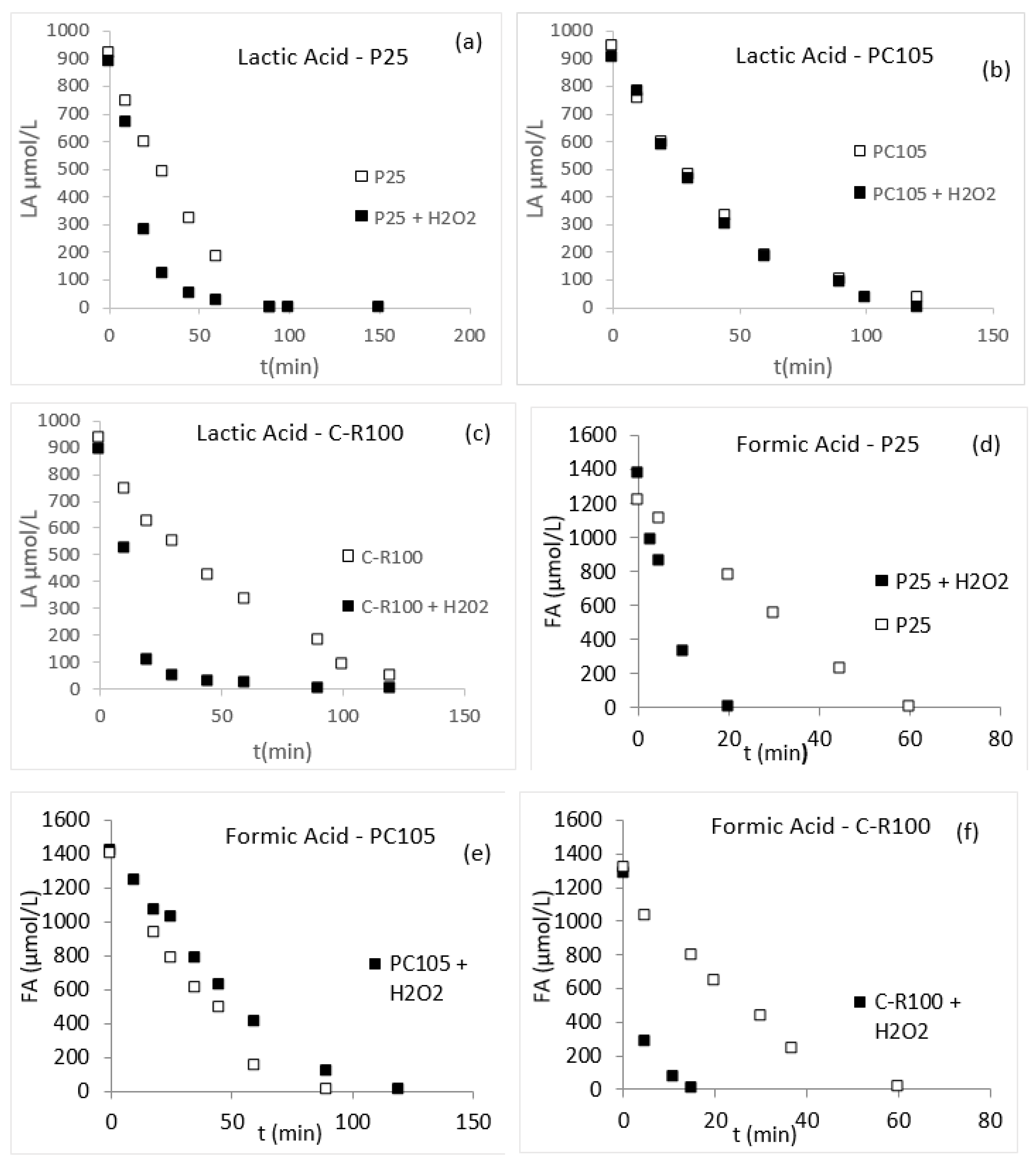
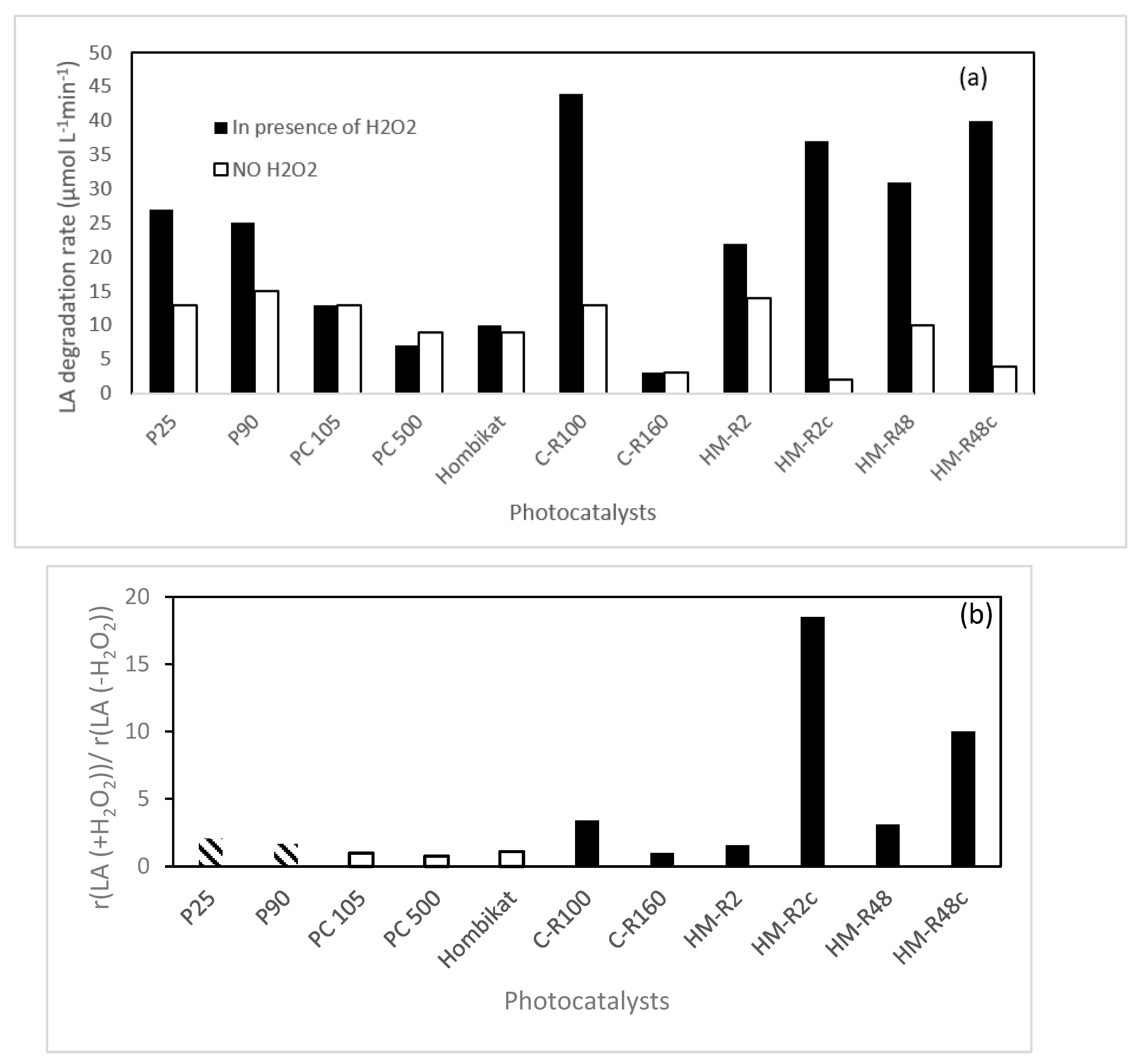



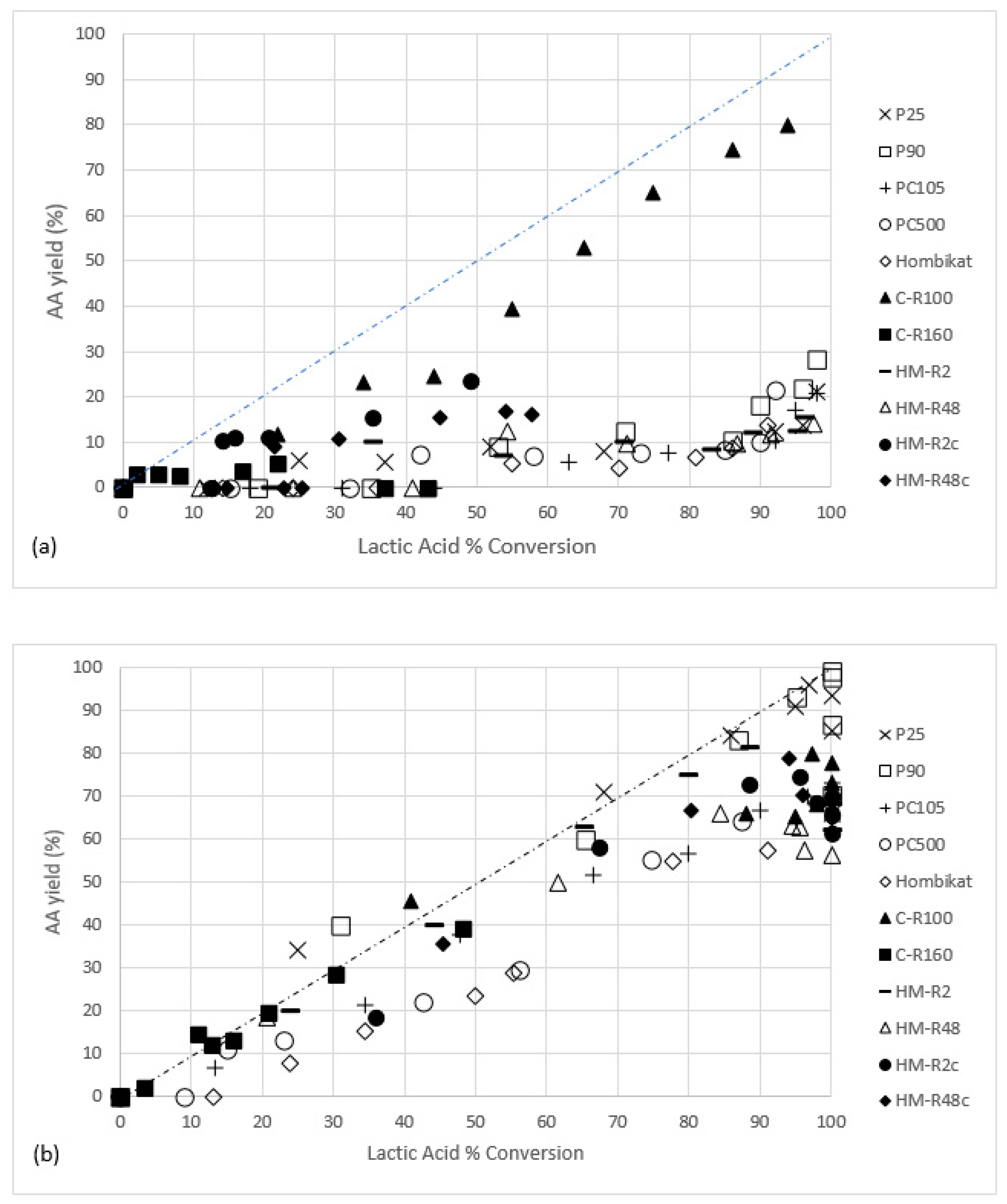
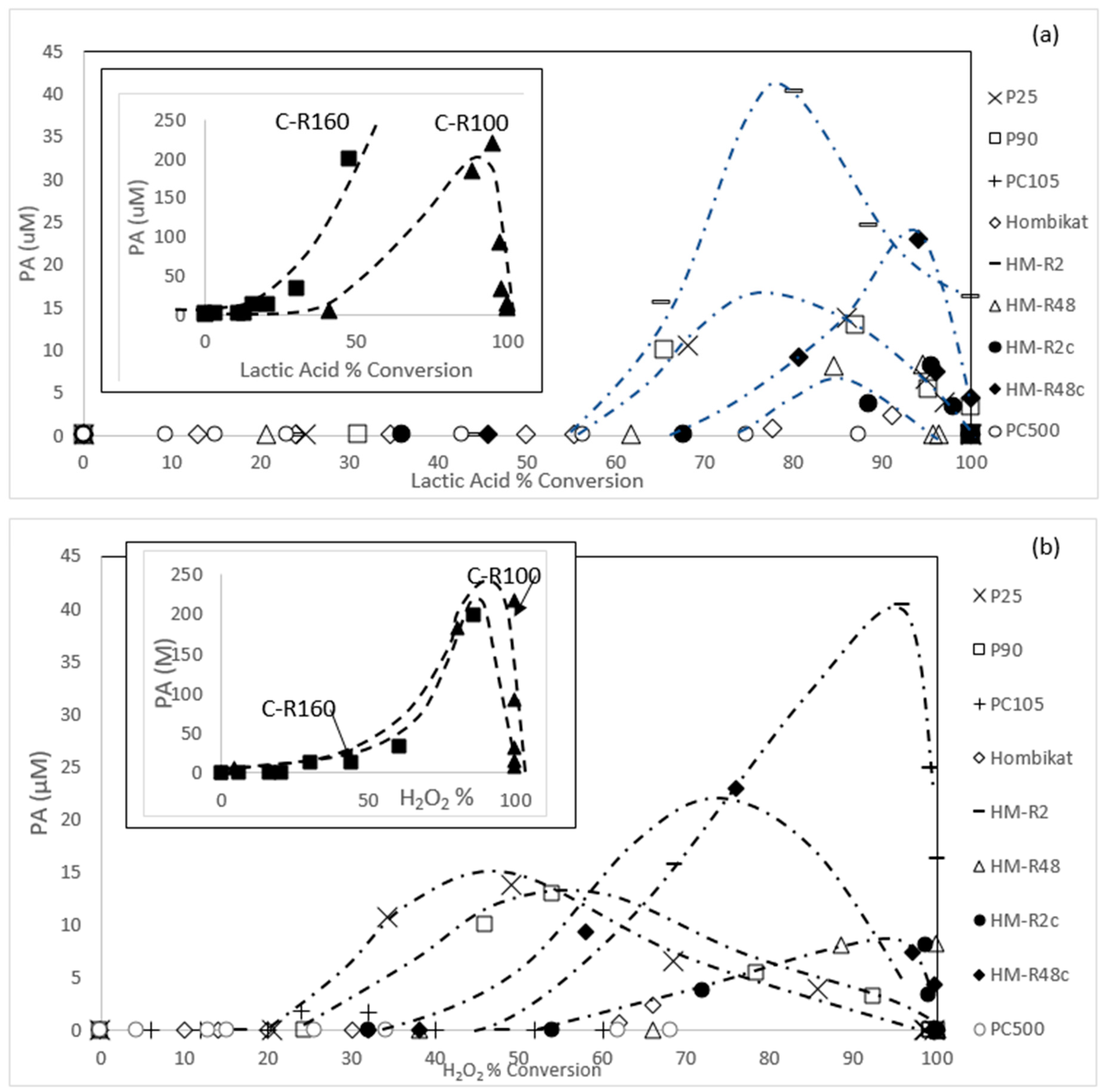
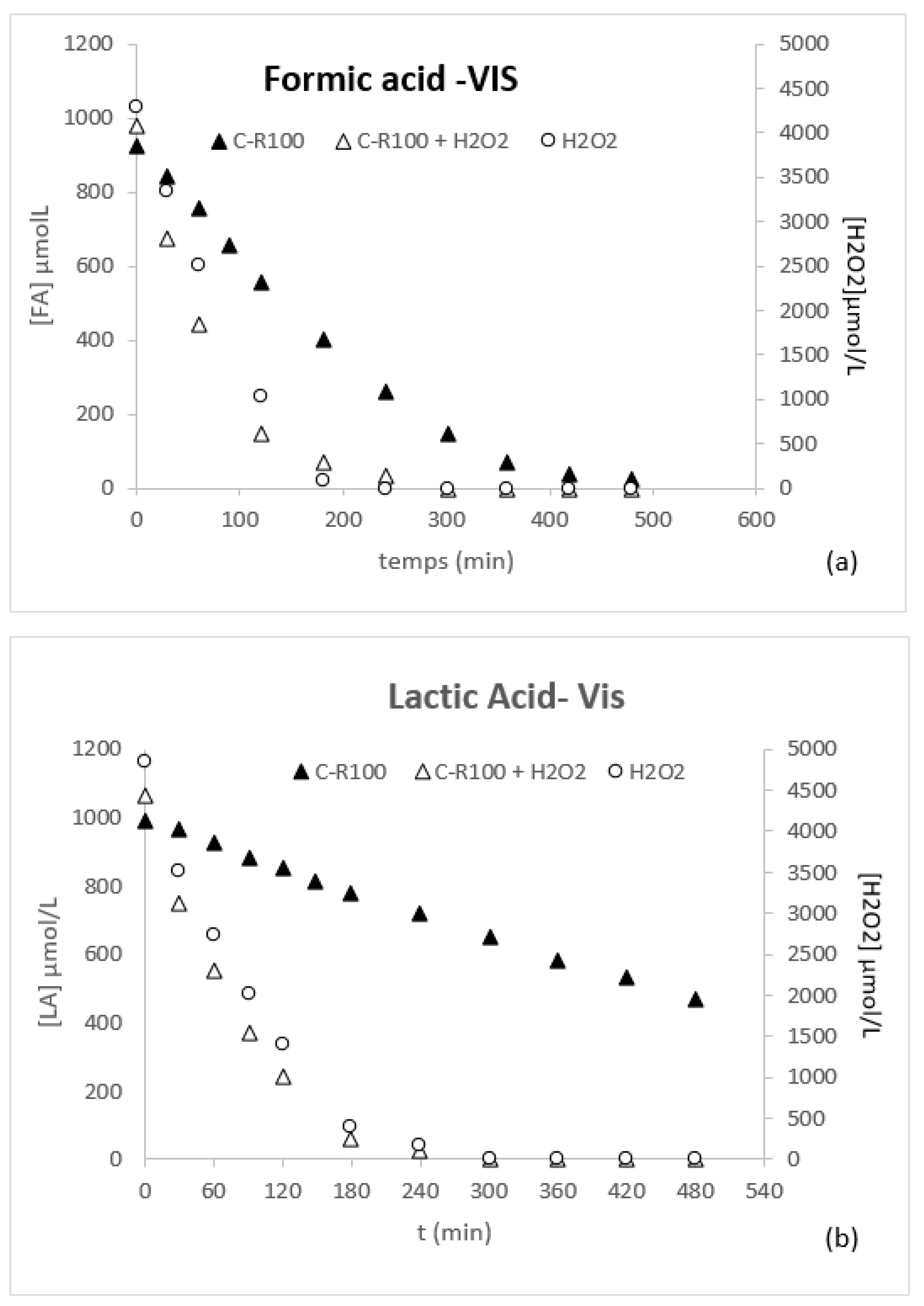
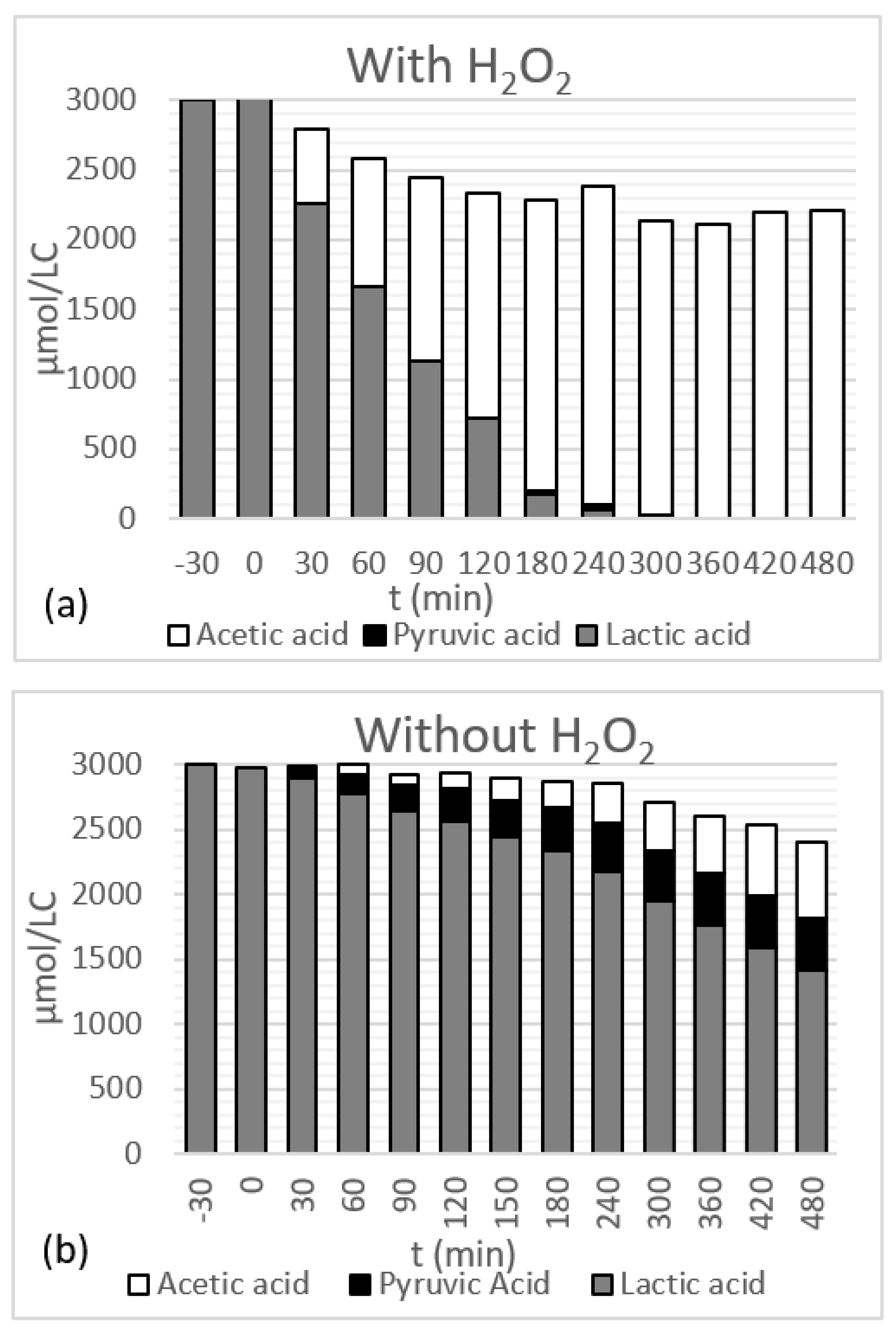
| Photo-Catalysts | Structure | SBET (m2·g−1) | Crystallite Size (nm) | IEP | Reference |
|---|---|---|---|---|---|
| P25 | 80% Anatase 20% Rutile | 50 | 21 − 30 | 7 − 6.4 | [29,30] |
| P90 | 80% Anatase 20% Rutile | 90 | 14 | 7− 6.6 | [29,30] |
| PC 105 | 100% Anatase | 88 | 15–25 | 4.7 +/− 0.5 | [28] |
| PC 500 | 100% Anatase | 340 | 5–10 | 6.2 | [29] |
| UV 100 | 100% Anatase | 300 | <10 | 5.3 | [30] |
| C-R100 (MPT 625) | 100% Rutile | 103 | 13 | 5.4 +/− 0.5 | [28] |
| C-R160 | 100% Rutile | 160 | 8–10 | 5.1 +/− 0.5 | [28] |
| HM-R2 | 100% Rutile | 173 | 7.5 | 4.3 | [28] |
| HM-R2c | 100% Rutile | 112 | 9.9 | 3.5 | [28] |
| HM-R48 | 100% Rutile | 117 | 10.5 | 4.4 | [28] |
| HM-R48c | 100% Rutile | 92 | 12.8 | 3.6 | [28] |
© 2020 by the authors. Licensee MDPI, Basel, Switzerland. This article is an open access article distributed under the terms and conditions of the Creative Commons Attribution (CC BY) license (http://creativecommons.org/licenses/by/4.0/).
Share and Cite
Holm, A.; Hamandi, M.; Sahel, K.; Dappozze, F.; Guillard, C. Impact of H2O2 on the Lactic and Formic Acid Degradation in Presence of TiO2 Rutile and Anatase Phases under UV and Visible Light. Catalysts 2020, 10, 1131. https://doi.org/10.3390/catal10101131
Holm A, Hamandi M, Sahel K, Dappozze F, Guillard C. Impact of H2O2 on the Lactic and Formic Acid Degradation in Presence of TiO2 Rutile and Anatase Phases under UV and Visible Light. Catalysts. 2020; 10(10):1131. https://doi.org/10.3390/catal10101131
Chicago/Turabian StyleHolm, Annika, Marwa Hamandi, Karima Sahel, Frederic Dappozze, and Chantal Guillard. 2020. "Impact of H2O2 on the Lactic and Formic Acid Degradation in Presence of TiO2 Rutile and Anatase Phases under UV and Visible Light" Catalysts 10, no. 10: 1131. https://doi.org/10.3390/catal10101131




